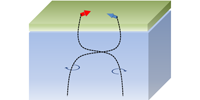Abstract
We discuss physical properties of “integer” topological phases of bosons in dimensions, protected by internal symmetries like time reversal and/or charge conservation. These phases invoke interactions in a fundamental way but do not possess topological order; they are bosonic analogs of free-fermion topological insulators and superconductors. While a formal cohomology-based classification of such states was recently discovered, their physical properties remain mysterious. Here, we develop a field-theoretic description of several of these states and show that they possess unusual surface states, which, if gapped, must either break the underlying symmetry or develop topological order. In the latter case, symmetries are implemented in a way that is forbidden in a strictly two-dimensional theory. While these phases are the usual fate of the surface states, exotic gapless states can also be realized. For example, tuning parameters can naturally lead to a deconfined quantum critical point or, in other situations, to a fully symmetric vortex metal phase. We discuss cases where the topological phases are characterized by a quantized magnetoelectric response , which, somewhat surprisingly, is an odd multiple of . Two different surface theories are shown to capture these phenomena: The first is a nonlinear sigma model with a topological term. The second invokes vortices on the surface that transform under a projective representation of the symmetry group. We identify a bulk-field theory consistent with these properties, which is a multicomponent background-field theory supplemented, crucially, with a topological term. We also provide bulk sigma-model field theories of these phases and discuss a possible topological phase characterized by the thermal analog of the magnetoelectric effect.
- Received 4 October 2012
DOI:https://doi.org/10.1103/PhysRevX.3.011016
This article is available under the terms of the Creative Commons Attribution 3.0 License. Further distribution of this work must maintain attribution to the author(s) and the published article’s title, journal citation, and DOI.
Published by the American Physical Society
Popular Summary
Are there unifying scientific concepts that define or distinguish physical states of matter? Symmetry has long been known to be such a concept, as illustrated by the contrast between the formlessness of liquid water and the hexagonal form of snowflakes, which evidences the breaking of the rotational symmetry of space. Topology, the mathematical framework that describes global characteristics of geometrical structures, has been recognized as another, as epitomized by the quantum Hall effect. Only very recently, theoretical physicists imagined, by combining symmetry and topology, a whole new world of exotic states of matter: symmetry-protected topological states of electronic materials.
The “topology” in this new context is associated with the twisting of electronic bands, and the symmetry-topology interplay is manifested in the form of unusual states that necessarily transform an insulator into a conducting material through its surface. Theoretical predictions based on the simplest form of these ideas, of topological insulators of noninteracting electrons, have received spectacular experimental confirmation. Do analogous phases arise more generally, when particles strongly interact with each other and when there is no notion of a band structure? Indeed, we find that many new phases appear with interactions. Here we determine the defining properties for a broad class of them.
We focus on symmetry-protected topological states in three-dimensional systems whose excitations in the bulk are characterized quasiparticles with an energy gap that behave like bosons. Remarkably, we find that interactions lead to a plethora of novel states that exist on the two-dimensional surface of such a material. The most fundamentally salient feature of these states is that they have symmetry properties that are impossible to realize in a purely two-dimensional electronic system. These states are not just a dream of theorists: They may potentially be realized in frustrated spin systems in solid materials or in systems of ultracold bosonic atoms confined to an optical lattice.



